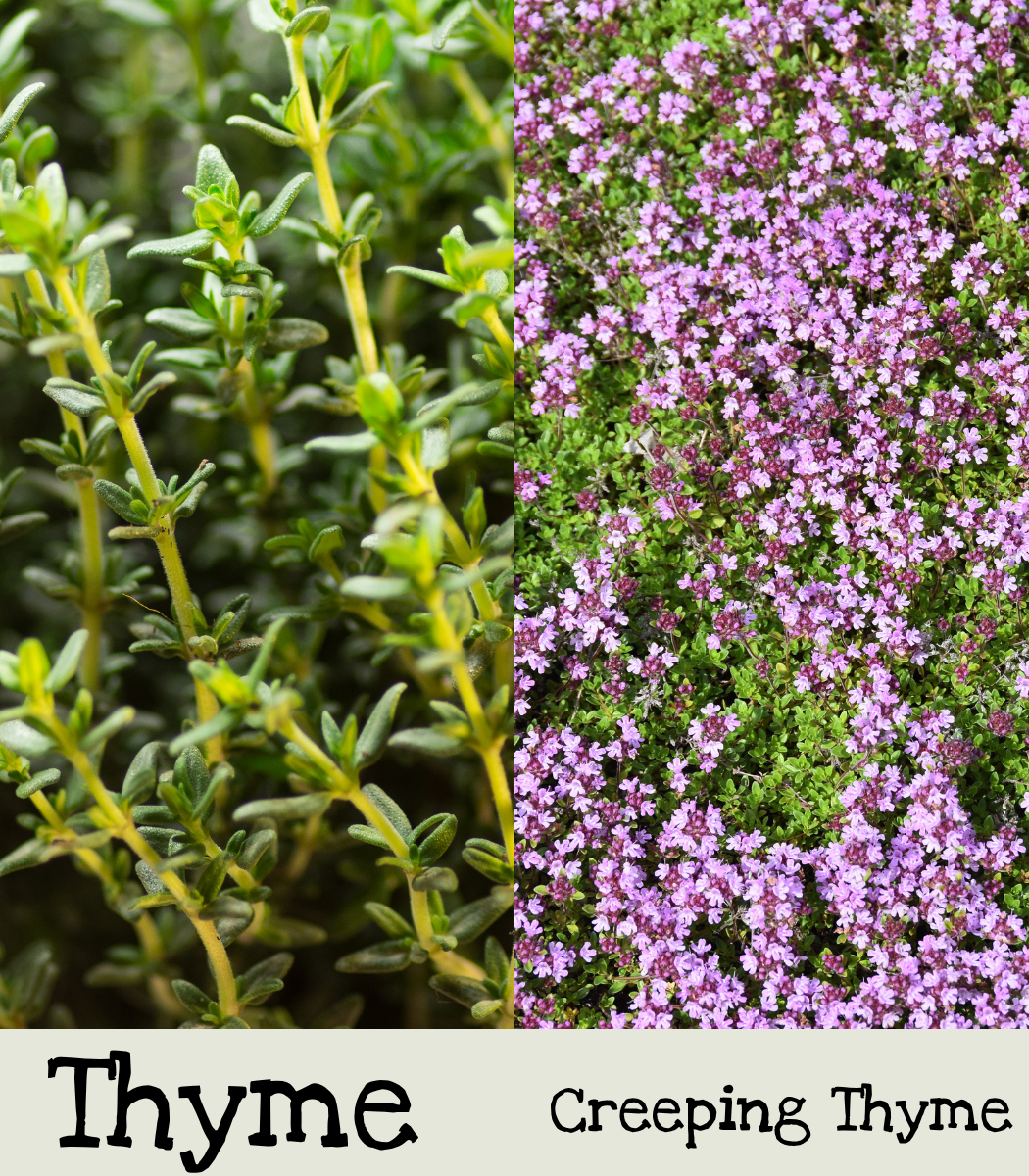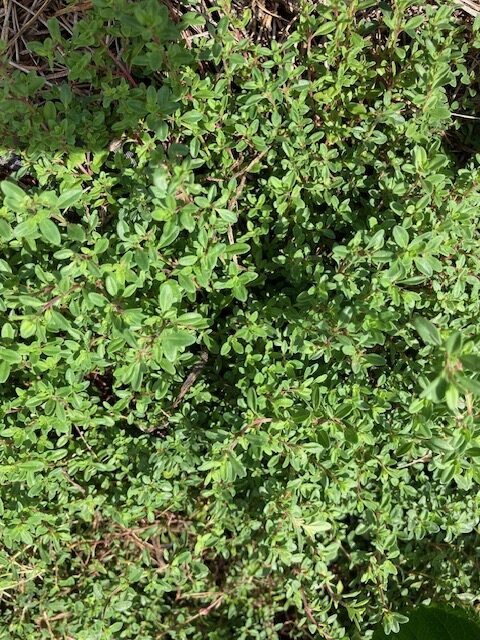
Thyme
Attractive to bees, this culinary herb is a member of the mint family. Thyme can be used to flavor meat, sauces, dressings, and beans. Creeping varieties can be used as living mulches and ground cover.
|
Common; German Winter Creeping Thymes: Creeping; Magic Carpet |
|
Creeping; Magic Carpet: Thymus serpyllum Common; German Winter: Thymus vulgaris |
|
Intermediate then Easy |
|
Intermediate |
|
3 years if properly stored |
|
Perennial in zones 4-10 |
|
14-30 days |
|
None |
|
Surface Sow |
|
Creeping Thymes
|
|
Needs light to germinate Full sun to part shade |
|
February and March |
|
Yes |

Growing Tips



When to Start
Spring: 8-10 weeks before the last frost. (End of February/beginning of March for GA)
Direct sow: Not recommended.
How to Grow
It is intermediate to start from seed then easy to grow.
Thyme seeds can be very slow to germinate and direct sowing is not recommended. Start indoors 8-10 weeks before the last frost date. As the seeds need light to germinate, surface sow them. Gently press the seeds into the seed starting mix. Thyme likes bottom heat ranging from 60-70 F. A heat mat is helpful to maintain a constant temperature. Place the cells under the grow lights.
Seedlings are ready for transplant when they are a little over 3 inches tall. Transplant after hardening off and all danger of frost has passed. Space plants 9-15 inches apart as they will spread. When planting thyme in a window box or other container, you should be able to get away with planting the seedlings closer together. When planting creeping thyme, you will want to space the plants the recommended distance so that it will grow and fill in the gaps.
Care
Thyme likes full sun and well-draining soil. Plant it in full sun beds or containers. Thyme doesn’t like wet feet and soggy soils can cause root rot. In hot climates, like the south, some afternoon shade would be beneficial. It is a perennial in zones 4-10, but it might become darker due to the winter temperatures.
Thyme should live for several years. If the plants start looking their age, prune them back hard to reinvigorate the plants. Bottom watering with a soaker hose is best to prevent diseases. If you must water from above, water early in the morning to allow the leaves to dry. Water bottle reservoirs are also helpful especially if planted in a container. Containers dry out quickly, especially in the hot afternoons. These reservoirs will help keep the soil moist and cool during the hot days of summer and help keep the soil from drying out in between waterings.
Harvest
Harvesting can be done throughout the growing season. Cut the long stocks leaving the woody stems. Harvest in the morning for peak flavor. Some recommend not washing the thyme to preserve the oils. But, considering where it grows and the kind of animals (birds, etc) that come and visit, washing is probably a good idea for sanitary reasons. There is enough flavor and oils in the leaves, washing will not damage the flavor when using dried or fresh.
Living Mulch or Ground Cover
Creeping thyme is excellent for use as a living mulch or ground cover. It can be used to help prevent erosion or to suppress weeds. It may take some time to spread and fill a large area. Follow the spacing instructions above and allow the thyme to spread filling in the areas you wish to keep weed-free. It should reach a max height of 4 inches and can be lightly tread upon.
How to use
Thyme comes in different varieties that have slightly different flavors. All are good in savory dishes. It is used in breads, soups, vegetables (like potatoes and carrots), and meats (like beef, chicken, and lamb).
Try using lemon thyme in desserts like lemon cakes, or zucchini breads to add an extra burst of flavor.
Thyme tea: Add 2 teaspoons of fresh or dried leaves to 1 cup boiling water. Let steep to desired strength then strain leaves. Mix it up by steeping it with black tea or other herbs.
Pro Tip!
Incompatibles: Cucumber
Grows well with: all brassicas (kale, broccoli, etc.), eggplant, potatoes, strawberries, and tomatoes
My personal experience
My favorite flavor of thyme is lemon. It can be hard to find and I’ve never seen it as seeds. It always comes as a seedling. I love the bright, slightly lemon flavor of this thyme. I use it as just as you would with any other kind of thyme, with one exception. When I make lemon zucchini bread, I add some chopped lemon thyme leaves. It really increases the lemon flavor of this sweet bread!
I plant my lemon thyme in containers. They have water bottle reservoirs and they get afternoon shade. My creeping thyme is planted in the blackberries. So, it gets full sun. I hope for it to become a living mulch. This is year one, so it is getting established and spreading a little bit.
Next year it should really take off! I’m hoping it will completely fill the area suppressing weeds. It would be nice if it bloomed too. Then there would be a sea of little purple flowers!

Seed Saving

Isolation Distance
Insect dependent for pollination. Isolate 1/2 mile from different varieties to prevent cross-pollination.
Instructions
Select healthy, robust plants free of any signs of disease or insect infestation for seeds. Seeds carry the traits of the parent plant. Choose plants that exhibit the traits you wish to preserve. Consider bloom size, color, and shape, as well as blooming time.
Allow the biggest and healthiest blooms to mature on the plant. Cover the seed head with a fine-mesh bag as soon as the start to turn brown. Use an elastic band to hold the bag in place. This prevents seeds from spilling onto the soil before harvest.
After the seeds explode in the bag, separate plant debris from the seeds by removing the mesh bag and placing the flower head in a paper bag, and shake to loosen the seeds. Seeds settle to the bottom of the bag. Remove plant debris by hand.
Features
- Attracts pollinators
- Culinary
- Low maintenance
- Container friendly
- Ground cover/living mulch
- Common: Heirloom. An aromatic herb that is used to flavor meats, soups, vegetables, breads, and more.
- German Winter Thyme: Good for flavoring meats, sauces, beans, and stuffing. German thyme has also been used medically.
Creeping Thymes
- Creeping Thyme: Both culinary and ornamental. Creeping thyme makes a good ground cover and works well in rock gardens.
- Magic Carpet: Heirloom. Drought-tolerant plants that have pink flowers and can tolerate foot traffic.

Bottom water to avoid dampening leaves, which can lead to disease. Or water soon enough so the leaves have time to dry.
Use water bottle reservoirs to help the plants get through the heat of the day in summer.
Sources:
Starting and Saving Seeds by Julie Thompson -Adolf
Burpee.com
Edenbrothers.com
The New York Botanical Garden, Herbal Handbook, Clarkson Potter.
Helmer, Jodi. Growing Your Own Tea Garden: the Guide to Growing and Harvesting Flavorful Teas in Your Backyard. Fox Chapel Publishers International Ltd., 2019.
